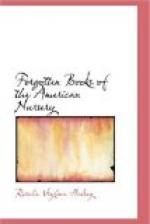Among the home contributors to “The American Juvenile Keepsake” were William L. Stone, who wrote a prosy article about animals; and Mrs. Embury, called the Mitford of America (because of her stories of village life), who furnished a religious tale to controvert the infidel doctrines considered at the time subtly undermining to childish faith, with probable reference to the Unitarian movement then gaining many adherents. Mrs. Embury’s stories were so generally gloomy, being strongly tinged with the melancholy religious views of certain church denominations, that one would suppose them to have been eminently successful in turning children away from the faith she sought to encourage. For this “Keepsake” the same lady let her poetical fancy take flight in “The Remembrance of Youth is a Sigh,” a somewhat lugubrious and pessimistic subject for a child’s Christmas Annual. Occasionally a more cheerful mood possessed “Ianthe,” as she chose to call herself, and then we have some of the earliest descriptions of country life in literature for American children. There is one especially charming picture of a walk in New England woods upon a crisp October day, when the children merrily hunt for chestnuts among the dry brown leaves, and the squirrels play above their heads in the many colored boughs.
[Illustration: Henrietta]
Dr. Holmes has somewhere remarked upon the total lack of American nature descriptions in the literature of his boyhood. No birds familiar to him were ever mentioned; nor were the flowers such as a New England child could ever gather. Only English larks and linnets, cowslips and hawthorn, were to be found in the toy-books and little histories read to him. “Everything was British: even the robin, a domestic bird,” wrote the doctor, “instead of a great fidgety, jerky, whooping thrush.” But when Peter Parley, Jacob Abbott, Lydia Maria Child, Mrs. Embury, and Eliza Leslie began to write short stories, the Annuals and periodicals abounded in American scenes and local color.
There was also another great incentive for writers to work for children. This was the demand made for stories from the American Sunday School Union, whose influence upon the character of juvenile literature was a force bearing upon the various writers, and whose growth was coincident with the development of the children’s periodical literature.
The American Sunday School Union, an outgrowth of the several religious publication societies, in eighteen hundred and twenty-four began to do more extensive work, and therefore formed a committee to judge and pronounce upon all manuscripts, which American writers were asked to submit.
The sessions of the Sunday-schools were no longer held for illiterate children only. The younger members of each parish or church were found upon its benches each Sunday morning or afternoon. To promote and to impress the religious teaching in these schools, rewards were offered for well-prepared lessons and regular attendance. Also the scholars were encouraged to use the Sunday-school library. For these different purposes many books were needed, but naturally only those stamped with the approval of the clergyman in charge were circulated.




